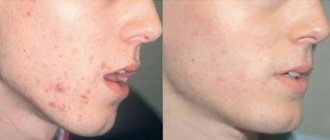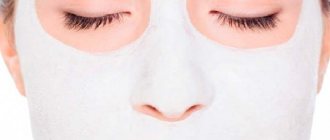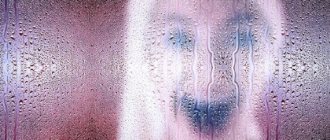Modern cosmetics are very diverse in composition, and it so happens that a new mask suddenly produces an unpleasant result - a red face after a mask, skin irritation, an allergy to clay. What to do in this case and what could be the reason? Despite the fact that the result is the same: after application the face turns red, it can be caused by various reasons.
What you will learn:
- Causes of facial redness after a mask Allergy to clay
- Features of the mask
- Skin irritation
- Poorly cleansed skin or dirty hands
- What to do to avoid redness
Red face after mask
A variety of ingredients can be used to prepare homemade masks, each of which can cause severe redness on the skin or local patches of irritation. There are several possible reasons for this phenomenon:
- Individual intolerance of varying degrees of severity. With allergies, the skin also itches and itches, and a rash may appear on it. If intolerance is severe, discomfort will occur even before the mask is removed from the face, and the skin will suffer quite severely. The redness may remain for a long time.
- Features of the composition of the mask. Some components affect the epidermis in such a way that blood rushes to it, and the subcutaneous capillaries greatly expand. Of course, such symptoms are not accompanied by itching and the appearance of rashes. Most often, this result is observed when using warming masks. If the face turns red precisely for this reason, then the redness will go away quite quickly - within a few hours after application.
- Non-allergic reactions. The mask can cause redness of the face if its components, when prepared at home, were not perfectly crushed and scratched the skin. Redness is also possible as a result of overdrying of the epidermis, which can occur when using a product that is not suitable for your skin type or when applied for too long. In particular, non-allergic redness often occurs after using a clay mask. This skin reaction usually goes away within a few hours, or at most within half a day or overnight.
To avoid redness of the skin when using masks, it is necessary to conduct preliminary allergy tests. To do this, you need to apply a small amount of the product to the thin skin of the inner bend of the elbow, rinse off after a quarter of an hour and evaluate the reaction of the epidermis.
Masks for chemical and mechanical peeling
Mechanical peel masks contain particles that can scratch the skin. This could be, for example, parts of an apricot kernel, pumice stone or grains of salt. Therefore, if your face turns red after a mask, most likely your delicate skin reacted with irritation to such exposure.
Chemical masks differ in the content of acids, which, although small, can still cause a chemical burn. In this case, the redness resembles sunburn.
What to do to avoid redness
To avoid unpleasant redness on the skin caused by the use of masks, you need to follow some recommendations.
- In case of allergies, you should consult a dermatologist - the doctor will tell you what could be the cause, and also prescribe medications to relieve symptoms. Of course, you need to avoid masks with the component that causes allergies and carefully study the composition.
- Select masks that suit your skin type.
- Before using the mask, you need to apply a little to a small area of skin on your arm and wait. If everything is in order, you can safely use the mask, but reddened skin or itching will warn you that it is better not to use the mask.
- Follow simple hygiene rules, clean your face before applying the mask and wash your hands.
- For delicate skin, it is better to choose masks that do not have too strong an effect.
- Follow the mask instructions if provided. Redness may appear because the mask has simply been left on the face for too long.
- Take care of your skin in a timely manner, using emollient creams and lotions appropriate to your skin type.
Following these simple tips will help you avoid redness on the skin associated with the use of masks, keep your skin healthy, and if trouble does occur, quickly deal with the consequences.
Redness after clay
Various clay masks are popular among women because they:
- Very affordable.
- Suitable for regular use.
- Promotes deep cleansing of the skin.
- Effectively relieve rashes.
- Eliminate inflammation.
- Helps cope with oily epidermis.
- They can whiten the skin, eliminate facial wrinkles, tone, moisturize and nourish.
Clay is considered a fairly hypoallergenic substance. Therefore, the risk of allergic reactions after its use is very small. However, after a clay mask, the face often turns red - locally or completely. Most often, this effect is explained by a temporary reaction of the epidermis of a non-allergic nature. During deep cleansing and warming up, redness is completely normal. Usually it goes away quite quickly.
But the possibility of allergies should not be ruled out. If the reddened skin itches and itches, and, even more so, if a rash appears on it, perhaps we are talking about individual intolerance.
Types of masks and the type of reactions they can cause
Depending on the type of mask, the most likely causes of redness may be different, therefore, the answer to the question - what to do if your face turns red after a mask will be different.
Masks with natural herbal ingredients
Such masks often cause allergic reactions, and if after the mask the redness does not go away and causes itching and burning, it means that some of the components caused the allergy. It is virtually impossible to predict in advance what is in the composition of the product that is responsible for the reaction.
However, it is worth noting that essential oils often cause allergies or irritation, so if your skin is sensitive, you should be careful with such masks.
In addition, natural ingredients expand pores and give a warming effect, so, for example, after a mask with honey or a mask with bodyaga, temporary redness of the face is normal.
Clay masks
Clay is often used for various masks, and its use is quite justified - this natural material has many beneficial properties . However, what to do if your face turns red after a clay mask?
What is the reason?
- Allergy to clay. You may also experience an allergic reaction to this product. It is also possible that an allergy will be caused by one type of clay, while others will be perceived as absolutely normal. This is due to the different composition of clay varieties.
- Natural reactions. Clay cleanses the skin, but can be slightly drying or tight, hence the red face after the mask. If your face turns red after a clay mask, but the redness is not too strong and does not cause discomfort, most likely it will disappear on its own in a couple of hours.
What to do?
Let's try to figure out what to do if your face turns red after the mask:
- Try lubricating your skin with Panthenol or Bepanten. This is a safe pharmaceutical cream that contains dexpanthenol, a derivative of one of the B vitamins. This substance effectively accelerates skin restoration, helps increase the density of collagen fibers, and also optimizes metabolism in cells. Creams with dexpanthenol are often used in the treatment of skin diseases and burns.
- You can also apply a regular moisturizer or nourishing cream to the skin.
- If there is severe itching and other symptoms of an allergic reaction, take any antihistamine, for example, Loratadine, Cetrin or Zyrtec in the amount of one tablet. Such drugs effectively eliminate the symptoms of individual intolerance in literally half an hour to an hour.
- If you suspect an allergy, do not use clay masks anymore.
- If there are no allergic manifestations, check how suitable the chosen product is for you. In particular, owners of combination skin should use some drying and deep cleansing compositions only on the T-zone, and on the cheeks such masks will naturally cause irritation.
If redness of the epidermis is a natural non-allergic reaction of the skin to clay, try to make the mask in the evening. Then the skin will have every opportunity to recover before morning.
The main symptoms of an allergy to a mask!
- Redness and swelling of the skin;
- The appearance of acne and various rashes, which can merge, forming spots of different diameters;
- Sneezing, coughing, lacrimation, shortness of breath, feeling short of air, asthma attacks;
- Headache, elevated body temperature, discomfort.
A regular single-layer mask is not designed to protect against allergens and allows large particles (dust, allergens) to pass through. Since condensation accumulates in it when worn, seasonal allergies develop faster and have more severe manifestations than usual.
Before purchasing a medical mask, you need to familiarize yourself with its composition. It is necessary to make sure that it does not contain harmful substances both in the composition of the fabric and in the interlayers used as a filter.
The sheet mask caused a burning sensation and redness of the face
The girls felt a burning sensation and found wounds on their faces after using a fabric cosmetic mask from Yes To. The Daily Mail reports this.
When Chelsea Anders saw a box of face masks at her local beauty store last month, she thought it would be a great Christmas gift for her 10-year-old stepdaughter Cadence. On Christmas morning, a little girl used the mask, and a couple of minutes later complained to her parents about an unpleasant burning sensation. The woman removed the mask from the child's face and discovered significant redness. The girl washed her face for 10 minutes every 20 minutes and then applied aloe vera before the redness went away.
Anders said that after her stepdaughter's unexpected reaction to the product, she decided to try the mask herself and received the same reaction.
“I had to use aloe vera for two days, and I couldn’t take a hot shower for three days because it was too painful,” Anders said.
Anna Weitzman, 26, said she bought the mask at a store in San Francisco for her friend because she thought it was safe, including for children. The manufacturing company did not position its product as a children's product, but the cheerful packaging design makes many buyers think that the product is aimed at children.
“I have used face masks from this company several times, so we had no concerns. But after about four minutes, my friend said that her face hurt, and then I started to feel a burning sensation. We washed our face to remove the remaining impregnation, but our face burned all day,” the girl recalls.
After this, Anna Weizmann could not wash her face with cool water or apply makeup for another day and a half - her skin was too sensitive.
The company has already withdrawn a batch of masks from cosmetic stores. The manufacturer has received dozens of complaints from customers. Social media was filled with photos of red-faced women using grapefruit vitamin C sheet masks and a skin-lightening mask.
Many girls said they were hesitant to remove the mask at the first sign of a burning sensation because the instructions on the back of the package warned of possible tingling and stated that this was a normal effect of using the product.
Dr. Jason Miller, a dermatologist at Schweiger Dermatology Group, says the tingling sensation from a face mask should be cause for concern.
“It’s the body’s way of telling you that something is wrong. When we perform chemical peels and remove a layer of skin, the procedure may tingle, but the process is monitored by a medical professional,” says the doctor.
It hasn't yet been determined which ingredients cause the painful reaction, but Dr. Miller says it could be anything, including vitamin C and lactic acid. The use of these substances in high concentrations may cause skin irritation.











